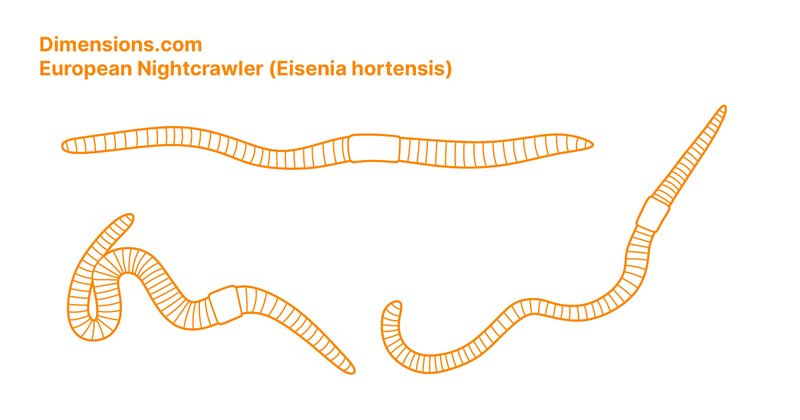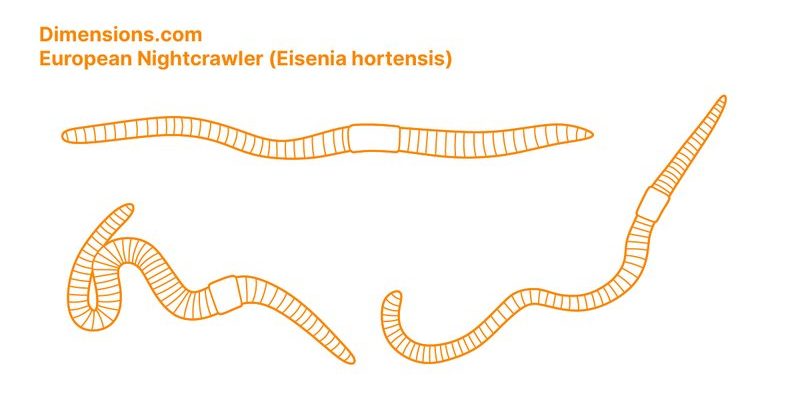
Think of *Eisenia hortensis* as nature’s little recyclers, tirelessly working to break down organic material and enrich the soil. Just like how you might adjust your routine with the changing seasons—like cozying up with a warm drink in the winter or enjoying outdoor picnics in the summer—these earthworms have their seasonal rhythm too. In this article, we’ll dive into the seasonal behavior patterns of *Eisenia hortensis*, exploring how their activities ebb and flow in response to environmental changes.
What is Eisenia Hortensis?
Before we jump into the nitty-gritty of seasonal behavior, let’s get a handle on what *Eisenia hortensis* actually is. This earthworm, often dubbed the “European nightcrawler,” can be found across various regions, particularly in Europe and North America. Known for their deep, rich color, *Eisenia hortensis* typically measures about 4 to 8 inches long. They thrive in moist, nutrient-rich environments, making them a common sight in gardens and farms.
You might wonder why they’re so important. Well, these little creatures play a vital role in soil health. They feed on organic material, breaking it down and turning it into nutrient-rich castings, which enhance soil structure and fertility. Without them, gardening and farming would be much less productive. So, understanding their seasonal behavior can help us appreciate their role more and improve our gardening practices.
Spring Awakening
As winter’s chill begins to fade and the days grow longer, *Eisenia hortensis* comes alive. During spring, these worms start to emerge from their burrows, hungry and ready to munch on the fresh organic material that’s accumulated over the winter. The increased moisture from melting snow and spring rains creates a perfect environment for them to thrive.
Here’s the thing: during this time, you’ll notice that *Eisenia hortensis* becomes more active in the top layers of soil. They begin to reproduce, laying eggs that will hatch into baby worms later in the season. Their increased activity is crucial for aerating the soil and distributing nutrients, which benefits not only the worms but also the plants that depend on a healthy soil ecosystem.
The Role of Temperature and Moisture
Temperature and moisture are key players in the behavior of *Eisenia hortensis*. With warmer temperatures and more moisture in spring, these earthworms become more mobile. They venture closer to the surface, helping decompose organic matter like fallen leaves and dead plant material. This not only feeds them but also enriches the soil, making it a win-win situation.
But it’s not all sunshine and rainbows. Too much rain can lead to flooding, which can push them out of their cozy burrows and cause stress. So, while they thrive in moisture, balance is essential for their well-being.
Summer Activities
As summer rolls in and temperatures rise, *Eisenia hortensis* tends to shift its behavior again. You might think that with longer days and warmer soil, these worms would be even more active, and for the most part, that’s true. However, they also become more cautious. Here’s where things get interesting.
During the hotter months, *Eisenia hortensis* often burrows deeper into the soil to escape the heat. The soil temperature can become quite high at the surface, so they seek cooler, more humid depths. This is why you might not see them as much during the day. Instead, they become more active during cooler periods, particularly at night.
The Impact of Soil Conditions
Summer brings its own challenges too. The drying effect of the sun can lead to drier soil conditions, which isn’t ideal for *Eisenia hortensis*. In response, they may enter a state of quiescence—essentially slowing down their metabolism and activity until conditions improve. This behavior helps them conserve energy and survive until the more favorable fall months arrive, where the cycle picks up again.
Understanding these adaptations is important. Farmers and gardeners can adjust their practices accordingly—like applying mulch to maintain soil moisture or timing irrigation to help these earthworms thrive.
Fall’s Bounty
As summer fades into fall, *Eisenia hortensis* gears up for one last burst of activity. The environment becomes cooler, and the soil remains moist—perfect for the worms to thrive. During this time, they’re often busy consuming decomposing plant material, which can include everything from fallen leaves to overripe fruits.
This feeding frenzy is crucial for soil health. As *Eisenia hortensis* breaks down the organic matter, they create rich castings that will enhance the soil structure for the following spring. It’s like nature’s way of preparing for the next season—clearing out the old to make way for the new.
Reproductive Patterns
Fall is also a key time for reproduction. With conditions just right, *Eisenia hortensis* lays more eggs to ensure that their population can bounce back come springtime. Each egg capsule contains several embryos, ready to hatch when the time is right. So, as they feast on organic material and enrich the soil, they’re also securing the future of their species.
This time of year highlights another important aspect of their behavior: their role in the ecosystem. By decomposing organic matter and enriching the soil, *Eisenia hortensis* helps create a thriving environment not just for themselves but for a variety of other organisms, including plants, insects, and even other soil-dwelling creatures.
Winter Survival Strategies
When winter arrives and temperatures drop, *Eisenia hortensis* has a different set of challenges to tackle. Unlike some other species, these worms can’t simply freeze and survive. Instead, they burrow deep into the soil where temperatures remain more stable. This is where a layer of organic matter, like leaves, acts as insulation.
Here’s the thing: during winter, their activity slows significantly. They enter a state of dormancy, relying on stored nutrients to get them through until warmer weather returns. This behavior is crucial for their survival, as it allows them to conserve energy in an environment that’s not conducive to their regular activity.
The Importance of Soil Quality
The health and quality of the soil during winter can significantly affect *Eisenia hortensis*. If the soil is rich in organic matter, it provides the necessary resources for them to survive until spring. However, if the soil is depleted, it can severely impact their population, leading to fewer worms in subsequent seasons.
So, maintaining good soil health year-round is essential for the survival of these earthworms and the overall ecosystem. Practices like composting, mulching, and reducing chemical fertilizers can help ensure that *Eisenia hortensis* has the resources they need to thrive.
Why Understanding Seasonal Behavior Matters
You might be wondering why all of this matters. Why should we care about the seasonal behavior patterns of *Eisenia hortensis*? Well, understanding their behavior can help us make better decisions regarding gardening and farming practices.
By recognizing when these worms are most active and what conditions they thrive in, we can create a more conducive environment for them. This, in turn, promotes healthier soil, which leads to more productive gardens and farms. It’s all interconnected, much like how a web holds together various threads.
Moreover, studying these behaviors can provide insight into the impacts of climate change. As temperatures rise and weather patterns shift, we might see changes in how *Eisenia hortensis* behaves, which could signal broader ecological shifts.
In wrapping up, the seasonal behavior patterns of *Eisenia hortensis* paint a vivid picture of how interconnected nature really is. These remarkable earthworms remind us that even the smallest creatures play a huge role in nurturing our ecosystems. By observing and understanding their habits, we can appreciate the natural processes that keep our soil healthy and our gardens flourishing.
So, the next time you’re digging in the garden or strolling through a field, take a moment to think about the *Eisenia hortensis* nearby. With every squirm and burrow, they’re doing their part to keep our planet vibrant and alive. In a world where we often focus on the big picture, let’s not forget the little guys who make such a huge impact.

